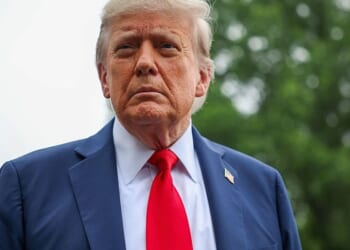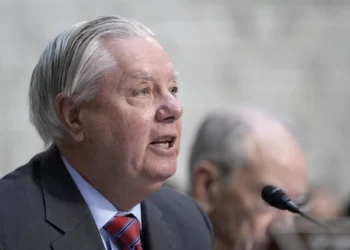President Donald Trump has centralized power in the White House to a far greater extent than during his first administration as he seeks to enact his sweeping agenda.
While Trump occasionally surprised Cabinet secretaries by making policy announcements on social media during his first administration, officials tell the Washington Examiner they had more freedom regarding their department or agency’s respective agendas.
Eight years later, a more experienced Trump exerts more control over policymaking and implementation, underscoring the importance of loyalty in the recruitment and retention of his top aides and federal government employees writ large.
“In 2017, Trump was unprepared,” Claremont McKenna College politics professor John Pitney told the Washington Examiner. “After the election, he threw out [former New Jersey Gov.] Chris Christie‘s transition playbook. In a scramble to staff his administration, he turned mostly to establishment figures who were skeptical about MAGA policies.”
But this time, he was ready, according to Pitney, a former Republican operative.
“He came back to office with four years of experience and knew the kinds of people he wanted to pick for key government posts,” he said. “For years, his subordinates had been planning executive actions and legislative proposals that he could launch early in his administration.”
Vanderbilt University political science professor David Lewis agreed, adding that Trump has also been able to exert more control over Congress during his second administration.
“In other presidencies, the agenda is set within the administration,” Lewis told the Washington Examiner. “The decision-making process is regularized in a way that makes it more predictable and that happens a bit less in this administration.”
Centralizing power
Law enforcement, particularly immigration, and foreign policy may be the best examples of Trump centralizing power in the White House in a manner different from his first term, with some criticizing Trump for going too far.
After contending with institutional guardrails during his first administration, Trump has upended the tradition of the Justice Department being independent of the White House during his second.
“Our predecessors turned this Department of Justice into the Department of Injustice. But I stand before you today to declare that those days are over, and they are never going to come back and never coming back,” Trump said in March during a rare presidential speech to the department. “So now, as the chief law enforcement officer in our country, I will insist upon and demand full and complete accountability for the wrongs and abuses that have occurred.”
Attorney General Pam Bondi has adopted more of an implementation role, with policy being directed by the White House, namely deputy chief of staff for policy Stephen Miller, including her defense of administration positions in court.
Miller has a similar dynamic with Department of Homeland Security Secretary Kristi Noem. She and her department and its agencies attempt to meet his target of arresting 3,000 illegal immigrants a day, though the administration last week started distancing itself from that number in legal proceedings.
Spokeswomen for Bondi and Noem did not immediately respond to the Washington Examiner‘s request for comment.
While Miller’s White House Domestic Policy Council has increased its influence during Trump’s second administration, the National Security Council has decreased. Many NSC staffers have been fired and Secretary of State Marco Rubio is acting national security adviser after his predecessor, ambassador to the United Nations nominee Mike Waltz, instigated Signalgate in March.
“Every administration has a different balance between the president, the NSC, and [the State Department],” Elliott Abrams, who served in the George W. Bush and first Trump administrations, told the Washington Examiner. “Two things are striking now. First, there is no NSC to work with. The NSC has largely been gutted, diminishing in size and responsibilities. Second, Trump himself is unpredictable. Add those together and there is really no policy process; you just have to get to Trump.”
Trump is also breaking with past practice when it comes to the military. He now meets with candidates up for promotion to four-star generals to personally vet the military leadership’s priorities.
Nathan Sales, Trump’s former coordinator for counterterrorism and special envoy to the Global Coalition to Defeat ISIS, added to the Washington Examiner: “It does seem to be the case that Trump 2.0 is centralizing national security decision-making in the White House.”
But former Trump Assistant Secretary of State for the Bureau of East Asian and Pacific Affairs David Stilwell countered that the president’s foreign policymaking and implementation process should be preferred because “authorities reside in the Cabinet,” not the NSC, which “can only convene meetings and recommend actions.”
“This concept was respected during Trump 1.0, ignored during the Obama and Biden administrations — the NSC assumed authorities it did not have, but the Senate-confirmed Cabinet secretaries didn’t object,” Stilwell told the Washington Examiner. “In the end, the president is responsible for developing foreign policy while the Cabinet executes it.”
As a result, Rubio is routinely at the White House, more so than some former secretaries of state, to be closer to Trump’s epicenter of power so he can better execute his dual responsibilities and improve his relationship with the president before the 2028 Republican presidential primary, in which he is speculated to take part.
“Rubio is doing great work. From my perch, it seems the focus of this admin is different than most previous in that State and DoD are no longer in the lead—it’s the three agencies related to business and prosperity: Treasury, Commerce and USTR,” Stilwell told the Washington Examiner.
A senior State Department official similarly reiterated that “there is only one commander in chief,” and that is Trump.
“America is stronger because of his leadership and direct engagement on the critical issues facing our country,” the official told the Washington Examiner.
Some leeway for certain secretaries
Trump’s relationship with his Department of Health and Human Services is one counterexample to his centralizing power in the White House.
HHS Secretary Robert F. Kennedy has had freedom concerning policy that his counterparts have not, as a former presidential candidate who campaigned for Trump and encouraged his Make America Healthy Again supporters to vote for the president last year, including his approach to federal funding for health research to his stance on vaccines.
“It’s definitely fair to say that President Trump trusts Kennedy on a lot of health matters,” a White House official told the Washington Examiner. “We have policy people who do health stuff and MAHA stuff, and they’re aligned. We work with them on that, and it’s a back and forth.”
From HHS’s perspective, a spokesperson described Trump and Kennedy as having “built a strong partnership rooted in trust and expertise.”
“Health policy is always aligned with the president’s vision, but he empowers HHS to take the lead on implementation, reflecting both his hands-on leadership and his confidence in Secretary Kennedy’s ability to drive meaningful results,” HHS spokeswoman Vianca Rodriguez Feliciano told the Washington Examiner.
However, in conversations with other administration departments and agencies, multiple spokespeople remained adamant to the Washington Examiner that their principal is in “lock step” with the president.
“President Trump was elected with a mandate from the American people to create a more effective and efficient federal government that serves all Americans, and [Environmental Protection Agency] is doing just that,” EPA press secretary Brigit Hirsch said.
A Department of Transportation spokeswoman even drew parallels between Secretary Sean Duffy‘s policy announcements and Trump’s executive actions.
“This is President Trump’s vision for America,” she said. “You can see if you watch the Cabinet meetings, the president knows what Sean Duffy is doing. It’s very obvious that he’s keeping very close tabs on what we’re doing here.”
Those conversations can be contrasted with those with the first administration’s Department of Veterans Affairs Secretary Robert Wilkie, who expressed pride in his independence from the White House.
“I actually had a great deal of autonomy,” Wilkie, who is now co-chair of the Trump-connected America First Policy Institute’s Center for American Security, told the Washington Examiner. “I did not have any day-to-day direction from the White House. My goal was to stabilize and reform the VA, and the way I worked was to keep the president up to speed on how those two goals were being achieved.”
But as Trump takes more executive action to empower himself and his administration’s political appointees, including a recent executive order requiring those appointees to approve all federal grant funding requests, George Mason University political science professor emeritus James Pfiffner argued a “hands-on” president can “be a good or bad thing,” depending on their judgment and personal capacity.
“He or she needs to know what their top advisors are saying,” Pfiffner told the Washington Examiner. “As long as the president is fully informed and that disagreements are not kept from the president for fear of shooting the messenger, hands-on control is legitimate and OK.”
200 DAYS IN OFFICE: TRUMP PIVOTS TO MIDTERM ELECTIONS AFTER ‘EXCESSIVE’ SECOND 100 DAYS
The White House concurred, asserting that “after four years of [former President] Joe Biden hiding in the basement, we finally have a commander in chief that enlisted his entire administration to implement the policies Americans voted for in November.”
“President Trump’s once-in-a-generation leadership is the reason the entire administration has delivered historic results in just 200 days,” White House spokeswoman Taylor Rogers told the Washington Examiner. “The president has selected the best Cabinet and staff in history, who are all working together to put America First.”















